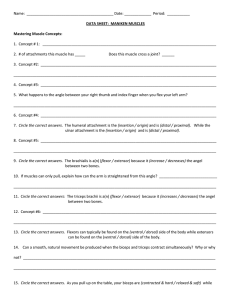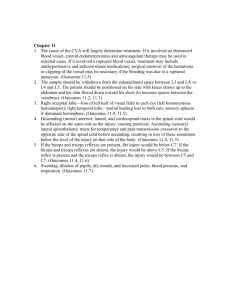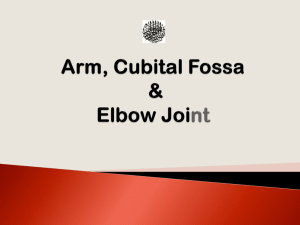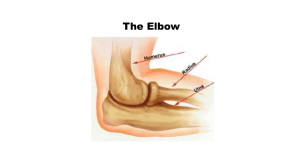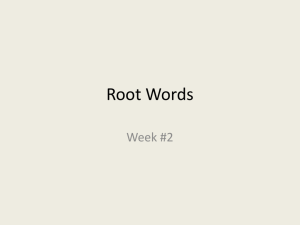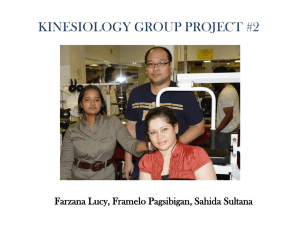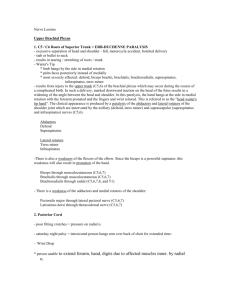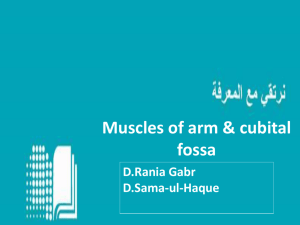Elbow Humeroulnar Joint
advertisement
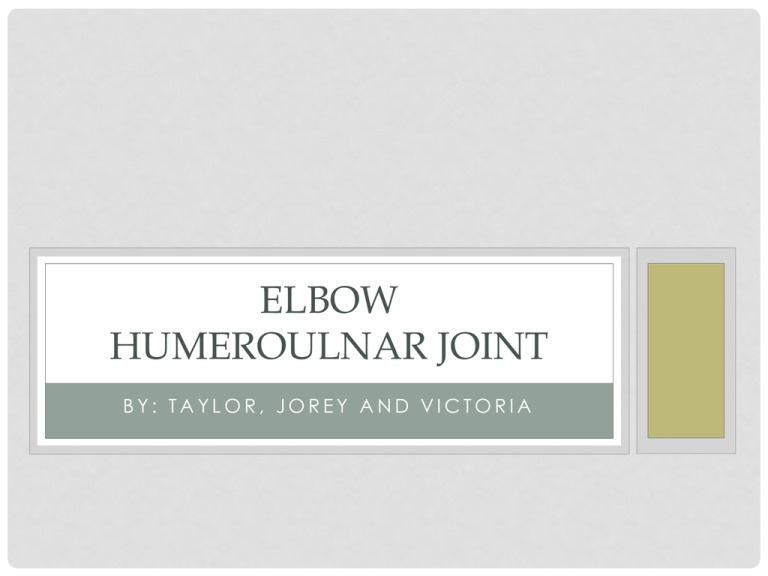
ELBOW HUMEROULNAR JOINT BY: TAYLOR, JOREY AND VICTORIA SURFACE ANATOMY • • • • • • • • • • Lateral epicondyle Medial epicondyle Radial styloid process Ulnar styloid process Olecranon Cubital fossa Carrying angle Medial bicipital groove Triceps tendon Biceps tendon LATERAL & MEDIAL EPICONDYLE • Lateral Epicondyle = A rough projection on the lateral side of the distal end of the humerus • Medial epicondyle =A rough projection on the medial side of the distal end of the humerus LATERAL & MEDIAL EPICONDYLE RADIAL & ULNAR STYLOID PROCESS • Radial Styloid Process = The shaft of the radius widens distally to form this process on the lateral side, which can be felt proximal to the thumb • Ulnar Styloid Process = Is located on the posterior side of the ulna’s distal end. RADIAL & ULNAR STYLOID PROCESS OLECRANON • Located at the proximal end of the ulna. It forms the prominence of the elbow CUBITAL FOSSA • The fossa in front of the elbow, bounded laterally and medially by the humeral origins of the extensors and flexors of the forearm CARRYING ANGLE • When your arms are held out at the sides and your palms are in supination, your forearm and hands should normally be about 5 to 15 degrees away from the body • This is the normal carrying angle of the elbow • It allows your forearms to clear the hips when swinging your arms, such as during walking • Because the carrying angle varies from person to person it is important to compare one elbow with the other when evaluating a patient CARRYING ANGLE MEDIAL BICIPITAL GROOVE • The groove along the medial surface of the arm separating the Biceps Brachii from Tricep Brachii TRICEPS & BICEPS TENDON • Triceps tendon = My be felt as it descends along the posterior aspect of the arm to the olecranon • Biceps tendon = Can be palpated in the cubital fossa, immediately lateral to the midline. BICEPS & TRICEPS TENDON BONES OF THE HUMEROULNAR JOINT Humerus The Humerus is the bone that is most proximal to the Upper extremity Contains- • Capitulum, • Trochlea • Coronoid Fossa • Medial Epicondyle • Lateral epicondyle • Olecranon Fossa BONES OF THE HUMEROULNAR JOINT CONT. • Radius and Ulna The Radius and Ulna are more distal of the Humeroulnar Joint and attach to Humerus Radius Contains- • Head • Neck • Radial Tuberosity BONES OF THE HUMEROULNAR JOINT Ulna contains• Olecranon Process • Coronoid Process • Trochlear Notch • Radial Notch • Ulnar Tuberosity BICEPS BRACHII • O:Short head: Coracoid process; • Long process: Supraglenoid tubercle of scapula • I: Radial Tuberosity and Bicipital aponeurosis • A: Supinates forearm, with forearm supinated flexes foreman, long head flexes arm • N: Musculocutaneous nerve • R: C5 and C6 SYNERGIST AND ANTAGONIST OF BICEPS BRACHII • S: Supination: Supinator Forearm Flexion: Brachialis, Brachioradialis Arm flexion: Coracobrachialis, Anterior Deltoid • A: Pronation: Pronator teres and quadratus Forearm extension: Triceps Brachii Arm Extension: Long head of Triceps, Posterior Deltoid, Latissimus Dorsi TRICEPS BRACHII • O: Long head: Infraglenoid tubercle of scapula, Lateral head: Posterior surface of humerus superior to radial groove Medial head: Posterior surface of humerus inferior to radial groove • I: Proximal end of Olecranon process of ulna • A: Extension of the forearm. Long head extends arm, resists dislocation • N:Radial nerve R: C6-C8 SYNERGIST AND ANTAGONIST OF TRICEPS BRACHII • S: Forearm extension: Anconeus Arm extension: Posterior Deltoid • A: Flexion of forearm: Brachialis, Brachioradialis, Biceps brachii Arm flexion: Biceps brachii, Anterior Deltoid BRACHIALIS • O:Distal half of humerus, anterior surface • I: Coronoid process and ulnar tuberosity • A: Flexes forearm • N:Musculocutaneous nerve • R:C5 and C6 • S: Forearm flexion: Biceps Brachii, Brachioradialis • A: Forearm extension: Triceps brachii BRACHIORADIALIS • O:Proximal 1/3 of lateral supra-epicondylar ridge of humerus • I: Lateral surface of distal end of radius • A: Weak flexion of forearm • N: Radial nerve • R:C5-C7 • S: Biceps brachii, Brachialis • A: Triceps brachii SUPINATOR • O: Lateral epicondyle of humerus, radial collateral and anular ligaments • I: Lateral, posterior, and proximal 1/3 of radius • A: Forearm supination • N: Radial nerve • R: C7 and C8 • S: Supination: Biceps brachii • A: Pronation: Pronator teres, Pronator Quadratus PRONATOR TERES • O: Ulnar head: Coronoid process of Ulna Humeral head: Medial epicondyle of humerus • I: Middle of lateral surface of radius • A: Forearm pronation, assistive in elbow flexion • N: Median nerve • R:C6&C7 SYNERGIST AND ANTAGONIST OF PRONATOR TERES • S: Pronation: Pronator quadratus • Flexion: Biceps brachii, Brachialis, Brachioradialis • A: Supination: Supinator, Biceps brachii • Extension: Triceps brachii PRONATOR QUADRATUS • O:Distal fourth of anterior surface of ulna • I: Distal fourth of anterior surface radius • A: Forearm pronation, binds ulna and radius together • N: Median nerve, Anterior interosseous nerve • R:C8,T1 • S: Pronator teres • A: Supinstor, Biceps Brachii NERVES • • • • Ulnar nerve Radial nerve Median nerve Musculocutaneous nerve NERVES 1. Musculocutanous nerve (C5-C7) 2. Radial nerve (C5-8, T1) 3. Median nerve (C5-8, T1) 4. Ulnar nerve (C7-8, T1) ULNAR NERVE RADIAL NERVE MEDIAN NERVE MUSCULOCUTANEOUS NERVE LIGAMENTS • Ligament = Connects bones to form a joint • • • • • Articular Capsule Radial anular ligament Ulnar collateral ligament Radial collateral ligament Interosseous membrane ARTICULAR CAPSULE • A sac enclosing a joint, formed by an outer fibrous membrane and an inner synovial membrane. Also call joint capsule RADIAL ANULAR LIGAMENT • This ligament encircles and holds the head of the radius in the radial notch of the ulna, forming the proximal radio-ulnar joint and permitting pronation and supination of the forearm INTEROSSEOUS MEMBRANE • A thin strong sheet of fibrous tissue between and connecting the shafts of the radius and ulna RADIAL COLLATERAL LIGAMENT • Extends from the lateral epicondyle of the humerus and blends distally with the anular ligament of the radius BURSAE • Subcutaneous Olecranon bursa • Subtendinous olecranon bursa • Intratnedinous olecranon bursa Bursitis: SUBCUTANEOUS OLECRANON BURSA • Is located in the subcutaneous connective tissue over the olecranon SUBTENDINOUS OLECRANON BURSA • Is located between the olecranon and the triceps tendon, just proximal to its attachment to the olecranon INTRATNEDINOUS OLECRANON BURSA • Is sometimes present in the tendon of triceps brachii. CARTILAGE • Articular cartilage = The cartilage covering the articular surfaces of the bones forming a synovial joint. ARTICULAR CAPSULE • Synovial membrane • Fibrous layer SYNOVIAL MEMBRANE • Lines the internal surface of the fibrous layer of the joint capsule and the intracapsular non-articular parts of the humerus. • It continuous inferiorly with the synovial membrane of the proximal radio-ulnar joint • The joint capsule is weak anteriorly and posteriorly but is strengthened on each side by ligaments FIBROUS LAYER • The outer fibrous part of the capsule of a synovial joint ARTERIES OF THE HUMEROULNAR JOINT • Arteries of the Humeroulnar Joint receive oxygenated blood from the heart Arteries here include • Brachial • Ulnar • Radial • Deep Brachial • Superficial Palmar arch ARTERIES CONT. Other Arteries involved• Posterior Interosseous • Recurrent Interosseous • Anterior Interosseous VEINS OF THE HUMEROULNAR JOINT • Veins of the Humeroulnar joint deliver deoxygenated blood back to the heart Veins here include • Cephalic • Brachial • Basilic • Median Antebrachial • Median Cubital • Dorsal Venous Arch (Network) CLINICAL CONCERNS OF HUMEROULNAR JOINT • Lateral Epicondylitis- Tennis elbow is an inflammation of the tendons that join the forearm muscles on the outside of the elbow. The forearm muscles and tendons become damaged from overuse — repeating the same motions again and again. This leads to pain and tenderness on the outside of the elbow. Causes of Tennis ElbowOveruse of the elbow joint in the use of sports not limited to…Playing Tennis TREATMENT OPTIONS FOR TENNIS ELBOW Non Surgical options• Physical Therapy • Braces • Non-Steroidal anti-inflammatory medicines • Rest • Steroid Injections • Shock Wave Therapy TREATMENT OPTIONS FOR TENNIS ELBOW • Surgical options• Open Surgery- The most common approach • Arthroscopic Surgery RESOURCES • Principles of Anatomy and Physiology Gerard J. Tortora and Bryan Derrickson 13th Edition • Essential Clinical Anatomy Keith L. Moore, Anne M. R. Agur, Arthur F. Dalley. • Gary Blevins Muscle List 2014 • Trail Guide To The Body Andrew Biel 4th Edition

